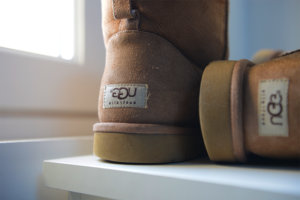
Cosy season is here and now is the perfect time to snuggle at home, wear some warm clothes and enjoy quality time with your friends and family. Ugg boots are a favourite addition to many people’s autumn and winter lives. These shoes are extra soft, lightweight and very comfortable. However, they require some extra attention, cleaning, and care.
The soft exterior of the boots, often suede, can easily become stained, scuffed, or simply dusty. While this would be the obvious problem that needs resolving, the inside of the shoes (especially those with thick fleece), also needs some TLC.
While some of the shoes that are made of synthetic materials and only resemble sheepskin can be machine-washed, those with real sheepskin must only be hand-washed. You should never attempt anything that is not suitable for the particular material of your shoes since damage and discolouration may occur.
Follow the instructions below to properly clean your Ugg (or other real sheepskin) boots.
Cleaning sheepskin boots
While the stains and marks on the outside of your boots are going to become quite obvious if not treated regularly, it is important that you do not ignore cleaning the inside of the shoes as well. Once the fleece inside becomes wet (either by water or sweat), bacteria growth will occur. That will cause unpleasant smells, as well as sticking of the fibres. Make sure you take the time to take care of the inside of your boots as well.
To prevent grime and dirt from building up too quickly, brush the outside of your boots with a suede brush in between deep cleanings. If you wear them a lot and they get grimy on a daily basis, do that on a daily basis.
- Brush the boots – Use a suede brush to get rid of loose soil, dust, and dirt from the fabric. You may want to do that outside to prevent creating a mess inside your house. Always follow the nap of the hide and start at the top, working your way down.
- Use a leather detergent when cleaning the boots more thoroughly. Carefully follow the directions and shampoo your boots, beginning at the top and working downward in gentle circular motions, taking care not to oversaturate the boots. Use a soft microfiber cloth. Allow them to dry naturally.
- Get rid of bacteria and fungus – If the inside of your boots smells funny, it is probably time to give it a good cleaning. Wipe down the inside of each boot with a disinfecting solution. Choose a pine oil or another disinfectant but never use bleach – it will cause the sheepskin hide to stiffen. Make sure you follow all instructions on the product label to avoid any damage. Regularly spray the inside of your boots with an anti-fungal spray to prevent bacteria from growing back.
- Air dry – Once you are done cleaning your boots (both inside and outside), let them air dry for at least 24 hours. Never wear your boots until they are completely dry – the combination of moisture and warmth will cause more bacteria and fungus to occur.
- To get rid of stubborn bad odours – Sprinkle 1/2 cup baking soda into each boot and let them sit overnight to help control odour. Empty the boots and vacuum out the baking soda the next morning to avoid leaving white tracks everywhere.
Stains on real sheepskin boots
- Water stains – If your boots get wet in a rainstorm, simply allowing them to dry without cleaning them can result in streaking or water stains. To remove water stains, begin with a white cloth or a sponge dipped in plain water. Wet the boots all over but do not soak or oversaturate them. When done, allow the boots to air dry. Stuff each damp boot with a rolled white towel to help the boots keep their shape while drying. If you use a dark-coloured towel, the dye may transfer to the boots. If you use newspapers, your feet and socks will be stained.
- Salt stains – Salt stains can occur on sheepskin boots after walking on salted roads after a winter. When the boots are moist, salt from the tanning process might rise to the surface of the skin and appear as stains. They can, however, be removed with a bit of effort.
Mix 1 cup water and 1 tablespoon distilled white vinegar, then wipe the salt-stained area with a white cloth or cotton ball. The acetic acid in the vinegar will dissolve the salt gradually. Then, wet the boots all over with a white towel or a sponge dipped in cold water. They should not be soaked. Allow the boots to dry naturally. - Oil stains – Simply walking outside can cause oil or grease stains on your sheepskin boots. Wash your hands before proceeding with the following steps to avoid transferring more oil to the boots.
Cover the oil stain with baby powder or cornstarch and leave it on for at least 24 hours. The oil from the boots will be absorbed by the powder. Brush the powder away using an old toothbrush. You may have to repeat the process to remove all of the oil stains from the suede.